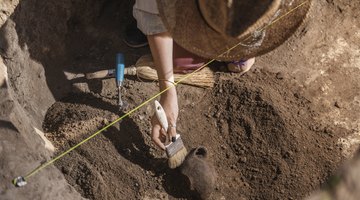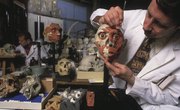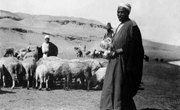The Study of Humans Through Time
Anthropology is the study of human beings and their societies or, as the American Anthropology Association defines it, “the study of what makes us human.” Many people describe anthropology as the study of humans by living among them.
These are two ways to approach anthropology, but other approaches exist as well. In the U.S., anthropology is divided into four subfields:
- biological anthropology,
- cultural anthropology,
- linguistic anthropology
- and archaeology.
By compiling data and sharing their findings, together, the four fields help provide a more complete picture of what makes us human.
Biological Anthropology

Biological, or physical anthropology, is the study of how humans have evolved biologically. By studying how the bones, skeleton, muscles and other parts of the human body function, experts can determine how humans have adapted through the years to survive.
- Biological anthropologists called “primatologists,” including Dian Fossey, study apes, monkeys and other primates to determine how they are similar and different.
- Human biologists study modern humans to analyze how their social status has affected their growth and development.
- Biological anthropology links biology with social science because of its study of biology’s relationship to human cultures.
Cultural Anthropology

Those who study human cultures different from their own to learn how they live, the rules they make that determine how they interact with one another, and their similarities and differences are called cultural anthropologists. Many times, they embed themselves within the culture, as Margaret Mead did in Samoa, to live as the people they’re studying actually live. Their goal goes beyond simply understanding that particular culture, but in applying what they learn to better understand humans all over the world.
Linguistic Anthropology

Linguistic anthropologists look at the ways people communicate in different societies and cultures and how their communication shapes their culture, their power structures and their relationships. They’re intrigued by the changes in communication that a society typically goes through over time.
While linguists study and compare different languages, linguistic anthropologists examine how language influences personal relationships and how that varies among cultures.
Franz Boas, a German who emigrated to the U.S. to escape anti-Semitism and is considered the father of American anthropology, contributed heavily to linguistic anthropological theory. His studies of the indigenous peoples of the Pacific Northwest helped debunk prevailing theories about the white race as more advanced and evolved and therefore superior. He demonstrated that while culture and language influence ideas and behavior, humans are essentially the same and equal the world over, regardless of race.
Archaeology

Archaeology is included as a subset of anthropology because digs are undertaken as a means of understanding how the people of different societies lived.
In archaeological digs, archaeologists may uncover human bones and teeth that yield clues as to how long the people lived and the diseases they suffered. Fragments of pottery help date the findings overall by examining how the pottery changed over time. Its shape also indicates how it was used, giving insight to how people lived. Burial sites reveal rituals the people practiced and give clues to the hierarchy of their society. The remains of structures show their location in relation to burial sites and trash pits or mounds. The findings uncovered by archaeologists are used by the other three branches of anthropology in different ways, depending on the focus of the anthropologists’ studies.
How Anthropology Enhances Other Studies
The findings of anthropologists and the theories that come from them make their way into other studies at all levels. In history and social studies classes, from elementary school through college, students learn about ancient civilizations from the work of archaeologists and how this work is interpreted by cultural and biological anthropologists. Linguistic anthropologists shed light on cave drawings and other early languages, attempting to explain how early people communicated and what was important to them. Written records that some societies left are helpful in adding to the understanding of earlier humans and their cultures. But, in many cases, written records are illegible or simply nonexistent, leaving anthropologists to examine physical remnants of societies to understand them.
Jobs in Anthropology
Most anthropologists work in research and development or as consultants in management, technical and scientific firms. Others work for the federal government, and a few are self-employed or hired by engineering services companies. Archaeologists often work in cultural resource management firms that assess and preserve archaeological digs, making sure developers in the area follow rules that are in place to preserve the sites.
The median salary for anthropologists and archaeologists in 2020 was $66,130, which means that half were paid more than that, and half were paid less. Those in federal government made $75,040, while workers in research and development earned $57,640.
- Top 10% Annual Salary: More than $102,770 ($49.41/hour)
- Median Annual Salary: $66,130 ($31.79/hour)
- Bottom 10% Annual Salary: Less than $40,800 ($19.62/hour)
Anthropologists may work in offices, where they typically work full-time during regular business hours. During fieldwork assignments, however, they usually work longer hours, including nights and weekends, and they may travel to distant locations to work on-site.
Educational Requirements
Students with a bachelor’s degree in anthropology or archaeology who have also gained experience through field schools and internships at museums and historical societies may work as field technicians or assistants. To work as an anthropologist or archaeologist, at least a master’s degree is required, which typically takes an additional two years of study beyond the undergraduate level.
Fortunately, many colleges offer online degrees in anthropology, so you can work at your own pace and on your timeline, while the little ones are napping or tucked in their beds for the night. Or, while school-aged kids do their homework, you show them that Mommy does her schoolwork too.
A Ph.D. is often needed to work internationally or in positions that require management skills and advanced technical knowledge. Earning a Ph.D. requires additional years of study and fieldwork—typically while working—and completion of a dissertation that can take as long as 30 months of information gathering through fieldwork. Knowledge of a foreign language is critical to fieldwork in international settings.
Related Articles
References
- Bureau of Labor Statistics: Occupational Outlook Handbook: Anthropologists and Archaeologists
- History-world.org: Anthropology: The International History Project
- American Anthropological Association: What is Anthropology?
- Rice University: Biographical Sketch of Franz Boas
- The Best Schools: The 5 Best Online Bachelor in Anthropology Degree Programs
Writer Bio
Barbara Bean-Mellinger is an award-winning writer in the Washington, DC area. She writes nationally for newspapers, magazines and websites on topics including careers, education, women, marketing, advertising and more. She holds a Bachelor of Science from the University of Pittsburgh.










